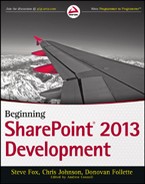Chapter 14
Developing Applications Using Office Services
WHAT YOU WILL LEARN IN THIS CHAPTER:
- Understanding the role of the new Office Web Apps Server
- Getting to know what’s new in Office 2013 and SharePoint 2013 application services
- Creating an app for SharePoint using Access and Access Services 2013
WROX.COM CODE DOWNLOADS FOR THIS CHAPTER
The wrox.com code downloads for this chapter are found at http://www.wrox.com/WileyCDA/WroxTitle/productCd-1118495845.html on the Download Code tab. The code for this chapter is divided into the following major examples:
- C14ExcelInteractive.zip
- C14ODataAccessSample.zip
- C14PPTAutomationSvcs.zip
- C14TranslateSPOM.zip
- C14WOPI.zip
The Office and SharePoint server-side application services provide a way to have server scale for automating traditional Office client document manipulation and Web scale for sharing, collaborating, and viewing documents with those who might not have the Office rich clients on the desktop. From a developer’s perspective, a number of APIs are available for you to leverage to call into these services to further enrich your solutions.
If you are unfamiliar with the application services present in SharePoint 2010, following is a list with a brief description of each one:
- Excel Services: Enables viewing of Excel documents in the Excel Web App and Excel Web Access web parts and provides programmatic access to document content via CSOM, REST, and OData.
- Word Automation Services: Provides conversion of document files supported by Word into other formats.
- Visio Services: Allows viewing of Visio documents in the Visio Web App and Visio Web Access web parts.
- Access Services: Provides the ability for Web databases constructed in the Access rich client to be deployed and hosted on SharePoint independent of the Access client.
The new Office 2013 and SharePoint 2013 application services in this release are as follows:
- PowerPoint Automation Services: Provides conversion of presentation files into other formats.
- Machine Translation Service: Synchronous or asynchronous requests are forwarded on to a cloud-hosted Microsoft service for language translation.
This chapter covers the Office 2013 and SharePoint 2013 application services that are new as well as some new features for the existing services. A deep look into Access and Access Services is provided because these products were significantly transformed in this release, providing the ability to generate an app for SharePoint that has an auto-provisioned Windows Azure SQL Database behind it. When Access generates the web pages for the app that will be hosted on SharePoint, it does so using standard web technologies — HTML, JavaScript, CSS, and so on — to be fully compliant with the new cloud app model. Developers can also submit these apps for SharePoint to the SharePoint Store on Office.com.
